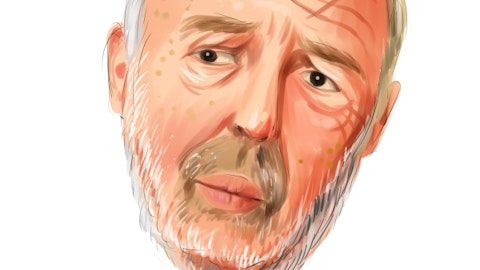Michael Perito: Got it. That’s helpful clarification, Frank. Thanks. And just — where is the pipeline I guess today? And how does it look kind of by product or geography? Just curious if there’s any more detail you can provide there?
Frank Sorrentino: Yeah. I mean, I would say that our pipeline is quite strong even today and it’s still pretty well diversified across the various aspects of the different verticals that we typically lend in. There is a little bit more emphasis in the C&I space. We’re seeing some improvements there, but I’m not sure it’s big enough to make enormous change in the balance sheet, but there’s definitely a higher focus there. And we are seeing probably more opportunities in some of those newer markets that we put some resources around or that we’ve made investments in, namely the Florida market, which has been performing extremely well for us, both in the size of the market we’ve created there and the loan to deposit ratio within that specific market as well as the Eastern Long Island market.
Those markets have been pretty exciting for us to watch throughout and we’re expecting really good things from both of those as we move into 2023. And additionally, all the other projects that we had around, whether it’d be a new vertical or a new place where we’re putting emphasis, the healthcare business being an example of that.
Michael Perito: Perfect. Thank you, guys, for addressing those. Appreciate it.
Frank Sorrentino: Thank you.
Operator: The next question is from the line of Daniel Tamayo with Raymond James. Please proceed with your question.
Daniel Tamayo: Hey guys, good morning.
Frank Sorrentino: Hi, Dan.
Bill Burns: Hi, Dan.
Daniel Tamayo: Maybe starting on the credit quality with reserves down to 1.12% here, just could get your thoughts on where you could see that ratio trending through the year given the economic uncertainty and the loan growth you’re expecting?
Bill Burns: Well, listen, with CECL, it’s really contingent upon where the forecast come out. And for now, although some of those metrics, those forecasts are declining, especially in terms of — projected GDP growth sales, those where the negatives are. But the unemployment rate is not really changing much in terms of economic forecast. Until you see that, you’re not going to see a ton of provisioning around the industry. So I think there’s a lot of misconceptions out there, but our CECL works and people think that it’s how we feel about where reserve levels used to be. And I think most bankers would agree yet, wouldn’t hurt to add to reserves, but that’s not what CECL is really allowing these days. So other than having specific reserves for specific credits, which we don’t have any, it’s all really contingent upon this black box model.
So if you think that at some point the unemployment rate forecast is going to increase, then you’ll see fairly significant increases in reserving. If you don’t, it’s probably going to be pretty much benign.
Daniel Tamayo: Okay, great. And I appreciate that. My only other question is just around the $10 billion in asset threshold. And you’re thinking that was likely you would cross this year, that’s still the case or if that’s changed at all with the economic forecasts?
Bill Burns: I think there’s a good chance we cross the $10 billion threshold. We’ve been preparing for it for a while. There are some costs associated with going over, but it’s pretty small for ConnectOne, those costs, and we’ve been building for this along the way. So I don’t really see too much change in our financial performance. And regardless of what’s going — one of the things I just want to add here is that, we’ve entered times before where things are a challenge, but we continue to produce year in year out very strong return metrics and credit quality metrics and I see no difference this coming year.
Daniel Tamayo: Great. I appreciate the color.
Operator: Our next question is from the line of Matthew Breese with Stephens. Please proceed with your question.
Matthew Breese: Good morning.
Frank Sorrentino: Hey, Matt.
Bill Burns: Good morning, Matt.
Matthew Breese: I wanted to go back to the NIM and NII. Bill, historically we’ve discussed kind of in a higher rate environment where the NIM floor could be. I think you’ve mentioned that perhaps in that 350 range was a good floor. It feels a bit lower now. And just how — touching on your incremental loan yields of 7% versus funding cost, it feels like incremental spreads are where the NIM is today or 100 bps lower quite a range.
Bill Burns: Right.
Matthew Breese: So I was just hoping you could give us some updated thoughts on realistically where you think that NIM could floor.
Bill Burns: Yeah. The thing that I have concerns about Matt is the increasing competition for deposits as the money supply continues to contract and it’s still is. I watched this every week as the numbers come out. And so, you have a couple of things. You continue to have more competition for interest bearing deposits. And secondly, there continues to be a flow out of noninterest bearing deposits for all banks, not just us. And so, this happened, really started taking effect in the middle of the fourth quarter and it was much more severe than I expected, the competition for deposits. And I’m sure you’re seeing in some other banks that you cover. So yes, on the margin right now, the new book — the new business we’re putting on is that spreads that are going to maintain our margins.
I am just concerned about those other factors that could cause a little bit of pressure. But this is a temporary situation. Things should settle out. The yield curve being inverted does not help anybody. If the yield curve goes back to its normal shape and the long end remains higher than it was a year ago, we — the banking industry and margins should be in good shape.
Matthew Breese: You had mentioned that incremental loan yield are in that 7% range, I am curious what are they rolling off at?
Bill Burns: They’re rolling off around about high 5% to 6%.
Matthew Breese: Okay. The other question just around NII, just thinking about 4Q NII $78 million, a little over $300 million annualized. Is that a number you think you can grow off of in 2023?
Bill Burns: Yeah, I would expect that we will grow that. I’d say, that the growth in the balance sheet will exceed any percentage decline in the net interest margin.
Matthew Breese: Okay. I’m sorry if I missed this, Frank, your earlier commentary around. Did you mentioned any loan growth guidance for the year?
Frank Sorrentino: I did not. I mean, sitting here, I would tell you that based on our pipeline, based on what we see relative to payoffs, I would tell you that it would be my anticipation we’d be growing in probably mid to high single digits.
Matthew Breese: Okay. Other question is, I know credit quality metrics today look very solid. As I think about new paper coming on at 7%, I would think there is also changes in cap rates. I mean, do you have any underlying concerns with the ability to keep NPAs and charge offs at these levels just given the higher interest rate environment or should we expect some normalization in those figures?
Frank Sorrentino: I would tell you that this doesn’t appear normal to me that all banks have virtually no delinquencies. I do think that there has to be some normalization around delinquency metrics and that there will be some level of credit issues going forward. I think it would be unrealistic to expect them to remain at zero. However, I do believe this is a very different environment than what we saw in 2008. I think real estate acts differently in this particular environment. I think there’s a lot more capital in real estate transactions than they were before. I think the inflationary environment has put a lot more money in people’s pockets. So I just think we’re going to see different types of credit issues. I just don’t have my crystal ball polished up to figure out where exactly that’s going to happen, but I just — just from history, it just can’t stay at zero, something’s got to break.





